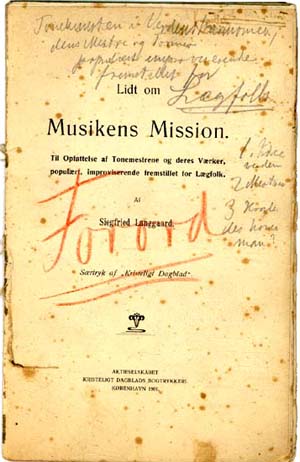The ideas behind the music
The mission of music
Siegfried Langgaard's ideas about the mission of music can briefly be
resumed as follows:
The Fall marked the beginning of mankind's earthly
struggles and sufferings, and the art of paradise, livskunsten (The Art
of Life), originally in harmony with the universe, was spilt up into various art
forms. Mankind's constant striving to be "like unto God", the
striving for salvation, is parallelled by the development of art from primitive
stages upwards towards manifestations of an increasingly spiritual nature. Like
mankind itself, art must go through a process of purification, which in the end
- in the fullness of time - will mean that the various branches of art will
again be united in the "harmony of the universe", which is one great
hymn of praise formed by the sum of a myriad of dialectically opposed
movements.
Geniuses are those who lead music further on in this development - composers such as Bach, Mozart, Beethoven and Wagner, whose musical dramas - especially Parsifal - were naturally milestones on the way to the highest form of spiritual art. Also César Franck, Bruckner and Niels W. Gade are placed high on the list. According to Siegfried Langgaard, the latter represented "the whole rosy-cheeked truth" of the world of music. On the contrary he cannot accept the perfumed, worldy scent spread by the music of Puccini and Richard Strauss!

In 1901 Siegfried Langgaard published this little book about the mission
of music.
Eight years later, Carl Nielsen published his article, "Words,
Music and Music with a Message", the content of which is in line with the
famous book by the music critic, Eduard Hanslick, "Om det Skjønne i
Musiken" (On the Sublime in Music) (Danish edition 1885).
Siegfried Langgaard was so indignant about Nielsen's views that in protest he
began to rewrite his own little book - and ended up with a work on the
philosophy of music in three volumes, filling more that 2,000 hand-written
pages of manuscript.
These writings have never been published, and are
certainly not suitable for publication, but Rued Langgaard inherited them, and
also to a large extent their ideology.
![]()